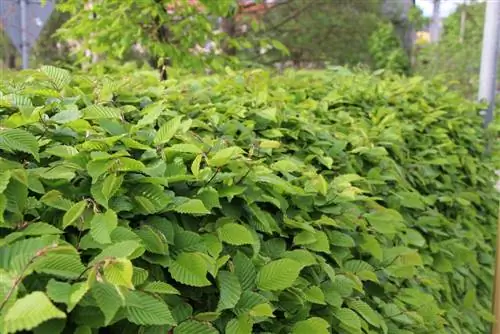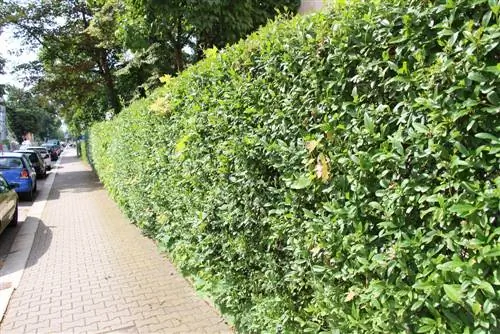- Author admin [email protected].
- Public 2023-12-17 03:39.
- Last modified 2025-01-24 12:45.
Since 2010, the legislature has regulated the pruning of hedges, bushes, living fences and other trees on a nationwide basis with the amendment to Section 39 of the Federal Nature Conservation Act. Among other things, the regulations set time limits that every garden owner should be aware of. The aim of the order is primarily to protect breeding birds and the entire ecosystem that can develop within hedges. Since the actual implementation is the responsibility of the states and municipalities, there are regional differences. Read here what the law says about bird protection.
Specifically defined time window
In paragraph 39, paragraph 5, the Federal Nature Conservation Act (BNatSchG) stipulates that from March 1st to September 30th, a hedge may not be cut down or put on the stock. This regulation applies to all populated and unpopulated areas, including private gardens and green spaces.
Tip:
The technical term putting it on the stick describes the radical cutting back of a hedge to around 20 cm above the ground. All shoots are shortened so that only one or two eyes remain on them from which the plant can sprout again.
Care cutting is allowed - with one restriction
The law on bird protection expressly allows gentle care cuts that serve to maintain the he alth of a hedge. These cutting measures may also be carried out between March 1st and September 30th.
The only requirement is that there are no nests of breeding birds or similar habitats of small wild animals within the trees. According to Section 39, Paragraph 1, Sentence 3, disturbing wild animals in their habitat without a reasonable reason is fundamentally prohibited, regardless of the season. How to act legally:
- Before pruning, carefully examine the hedge for nests and small animals
- If the bushes are populated or animals have stored food here, the cutting measure is postponed
- Otherwise, slightly shorten branches protruding from the shape
- It is also permitted to clean out withered flowers
- Dead wood can also be thinned out within the grace period
Since a radical rejuvenation cut in the middle of the vegetation phase does not make sense for most woody species anyway, the Federal Nature Conservation Act does not mean any real restrictions in the care program for the expert gardener. The best time for shape and maintenance pruning of ornamental and commercial trees is in late winter between the end of December and mid/end of February.
Care
Anyone who goes to work even though small animals have retreated into the hedge for their hibernation or is simply seeking protection from frost and snow is committing a criminal offense.
Tip:
The Federal Nature Conservation Act clearly distinguishes between trees and hedges. Trees in home and allotment gardens are not subject to the ban on cutting and felling between March 1st and September 30th. However, this only applies under the condition that there are no animal habitats in it or that other nature conservation regulations apply, such as the tree protection statute.
Facade greenery is considered a hedge

The regulations of the bird protection decree do not only apply to free-standing hedges. Rather, the ban on cutting during the summer months also applies to green facades. Here birds find a safe refuge to raise their offspring, out of reach of cats and other predators. Between March 1st and September 30th it is therefore forbidden to remove climbing plants from walls, fences or pergolas. Light pruning is permitted provided that it can be ruled out in advance that there are no breeding grounds in the branches.
Exceptions to the rule
The regulations mentioned regarding hedge trimming and bird protection do not apply if it is an officially ordered measure. Among other things, the order refers to traffic safety. If a hedge poses a threat, the urgency of cutting or clearing is prioritized over animal protection. This applies, for example, if the hedge threatens to tip over onto the street or sidewalk after a storm. In this case, we recommend contacting the nature conservation authority or the public order office to be on the safe side when carrying out cutting and clearing work.
Another exception is viewed critically by conservationists. The law states that minor woody growth may be removed for permitted building projects if it hinders the realization of the building project. Since there is a lack of a precise definition of 'minor', animal rights activists see a back door for arbitrary clearing of hedges and bushes. In fact, this measure is already subject to an official review as part of the building application, which is carried out with the appropriate sensitivity for the protection of bird life.
Observe regional regulations
The legislature delegates the implementation of the bird protection law to the states and municipalities. The defined period from March 1st to September 30th may not, of course, be shortened at the state level. However, an extension of the time window is permitted, as is a stricter interpretation. This flexibility is due to the fact that not all regions of Germany have the same flora and fauna. The following two examples illustrate the regional differences according to which the hedge trimming regulations can be interpreted:
InNorth Rhine-Westphalia Section 39 Paragraph 5 of the BNatSchG is adopted verbatim. Here, hedge trimming and planting on the sticks are prohibited between the dates mentioned. The interpretation is justified, on the one hand, by bird protection. On the other hand, the radical pruning of the branches down to their canes is seen as a serious incision in the regional landscape.
InHamburg, on the other hand, the said paragraph is interpreted in a more differentiated way. In this federal state, the care cut should not take place before June 24th, St. John's Day. No more than the most recent increase may be shortened.
It is therefore recommended that you find out about the specific regulations that apply in your federal state and municipality. It is not uncommon for small communities to pursue individual goals in animal protection and to set up strict regulations that property owners and gardeners must adhere to.
Tip:
In addition to nature conservation, noise protection is very important in Germany. Always use a motorized hedge trimmer in residential areas during permitted operating hours. As a rule, these extend from 9 a.m. to 1 p.m. and from 3 p.m. to 5 p.m. on weekdays.
Severe pen alties

The legislature is emphasizing its regulations regarding hedge trimming and bird protection with significant fines. Depending on the federal state, gardeners who ignore the legal regulations can be asked to pay a lot. In Lower Saxony, the illegal removal of hedges is punished with up to 25,000 euros. In Bavaria the fine amounts to up to 15,000 euros. Pen alties apply regardless of whether the violation was intentional or negligent.
Conclusion
Bird protection is important in Germany when it comes to hedge and tree trimming. The Federal Nature Conservation Act clearly states that no hedge may be cut, planted or even cleared between March 1st and September 30th. Anyone who ignores this legal regulation can be punished with fines of up to 25,000 euros. Moderate maintenance cuts are in principle permitted within this grace period. Of course, the scissors may only be used if no birds or other small animals have chosen the hedge as a kindergarten for their offspring. This requirement also applies during the winter months, as disturbing wild animals within their habitat is prohibited all year round. However, if hedges pose a threat to traffic safety or if an official measure is applied, bird protection is downgraded. Since the specific implementation of paragraph 39 in the BNatSchG is a state matter, gardeners should familiarize themselves with the regional regulations before trimming a hedge.






